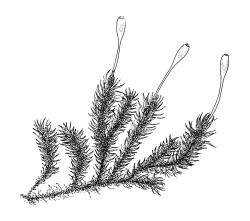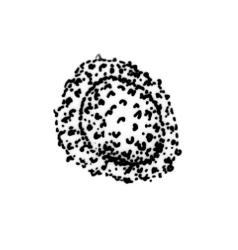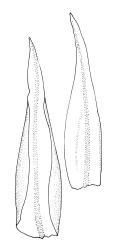- = Ulota anceps Venturi in Brotherus, Öfvers. Finska Vetensk.-Soc. Förh. 35: 42 (1893)
- = Ulota viridis var. adpressa Mitt. ex Malta, Acta Horti Bot. Univ. Latv. 7: 22 (1933)
- = Ulota dixonii Malta, Acta Horti Bot. Univ. Latv. 7: 19 (1933)
- = Ulota novae-seelandiae Sainsbury, Bull. Roy. Soc. New Zealand 5: 223 (1955)
Plants yellow-green above, pale or yellow-brown below. Stems much forked and ± creeping. Leaves erect-spreading when moist, weakly contorted and often ± spiralled around stem when dry, lanceolate from an ovate and pigmented base, narrowly or broadly acute, usually narrowly recurved near mid leaf on 1 or both sides, mostly 1.5–2.2 × 0.3–0.5 mm (under cover slip); upper laminal cells rounded, ± isodiametric or short-elliptic, usually some oblate, mostly 9–12 µm in greater diam., unistratose, mammillose (but mammillae usually visible only in profile); basal interior cells apparently smooth, yellow, oriented parallel to the costa; ± linear, porose and ± sinuose, mostly 20–30 µm long; cells of basal margins pale, with strongly thickened transverse walls, forming a distinct border mostly 4–6 cells wide and extending nearly to the top of the leaf base. Costa ending shortly below the leaf apex. Gemmae absent.
Gonioautoicous. Perichaetial leaves slightly larger than vegetative, the innermost erect and ± clasping the setae, mostly c. 2.5 mm. Setae elongate, c. 3.5–4.0 mm, dextrorse; capsules exserted, oblong-cylindric, strongly 8-ribbed when dry, c. 1.8–1.9 mm; exothecial cells as per genus; stomata numerous, extending to the lower portion of urn; operculum rostrate from a conic base. Peristome double; exostome teeth paired, broadly triangular, with a median zig-zag line clearly visible on both surfaces, inserted close to capsule mouth and c. 240–270 µm long, papillose-striolate (ornamentation not shown in illustration), reflexed when dry; endostome segments fragile, 8, c. 0.8 the height of the teeth, narrow, predominantly 1 cell wide, smooth or weakly ornamented (not accurately illustrated here). Calyptra campanulate, becoming split on 1 side with age, densely hairy, enclosing the operculum and urn of the developing capsule. Spores unicellular, spherical, green, (24–)27–36(–42) µm, coarsely papillose.
Malta 1933, figs 1 i–k, 11, 12.
Confusion could occur between U. viridis and Macrocoma tenue. However, the larger and narrowly acute leaves of U. viridis contrast with the shorter (mostly < 1 mm), broadly acute leaves of M. tenue. The Macrocoma also lacks the elongate basal cells and the incrassate basal marginal cells seen in virtually all species of Ulota.
In poorly developed material, confusion sometimes occurs between U. viridis and U. lutea. In well-developed material the leaves of U. viridis are decidedly less contorted when dry than those of U. lutea. The leaf base is generally less well-defined in U. viridis but this is not considered here to be a reliable character in itself. In difficult collections, the predominantly one-cell-wide endostome segments and the smaller spores (usually < 36 µm) of U. viridis help to distinguish the two species.
NI: S Auckland, Taranaki, Hawke’s Bay (South Makaretu), Wellington (Mt Ruapehu, Mt Tongariro); SI: Nelson (St Arnaud Range, Rahu Saddle, Paparoa Range), Canterbury, Westland (Croesus Track, Ōtira, Ferguson Creek), Otago, Southland (Borland Burn, Lake Manapōuri, Gertrude Valley); St.
Australasian. Tasmania*; recorded from Victoria by Scott & Stone (1976, p. 244).
Most often on trunks of Fuscospora solandri s.l. but also on Lophozonia menziesii; occasionally occurring on small branches. Also on Coprosma spp., Discaria toumatou, Dracophyllum spp., Leptospermum scoparium, Phyllocladus alpinus, and Cordyline australis, and the exotic genera Pinus, Betula, Larix, and Quercus; very rarely occurring on rock. On the South I. occurring from c. 250–1400 m. Frequently associated with Macrocoma tenue, Ulota lutea, and U. membranata, a range of hepatics including species of Radula, Frullania, and Metzgeria, and Menegazzia nothofagi. Although not restricted to eastern regions, this species is more common and better developed in drier parts of the country. More than 75% of the specimens in CHR are from Canterbury and Otago L.D., where it is widespread and relatively common.
The creeping and much-branched stems of this species, together with the relatively small leaves with a weakly-defined ovate base, are the most distinctive and reliable features of the present species. The creeping and branched habit is in many ways suggestive of a Macromitrium, but the distinct border of pale cells with strongly thickened transverse walls at the leaf base preclude confusion with species of Macromitrium. The very narrow endostomal segments in U. viridis can often be observed under the stereoscope in dry material. The peristome detail here (Image: Image\2FF2, I) does not illustrate the papillose-striolate ornamentation of the paired exostome teeth.
The type material of U. novae seelandiae Sainsbury lies within the range of continuous variation of U. viridis with respect to vegetative leaf size and spore dimensions. The type collection of U. novae-seelandiae contains few capsules; in one the capsule spores were found to be 34–42 µm diam. Another capsule (of only two seen) in the type has mostly malformed spores, some persisting in tetrads. Similar malformed spores have been seen in A.J. Fife 9912 (CHR 512694) from Arthur’s Pass. In habit Sainsbury’s type is indistinguishable from U. viridis.
It is clear that Malta (1933, p. 24) was uncertain about the value of the variety U. viridis var. adpressa Mitt. ex Malta prior to its publication. The primary character that he used to distinguish the variety is the length of the exostome teeth, which he considered to be "shorter than in the type" and "usually splitting afterwards". There is no information in Malta’s protologue to distinguish any of the three syntypes of this name. However, in Beckett’s herbarium (at CHR), an ample duplicate of the Mt Bonpland syntype bears the annotation in Brotherus’ script "Ulota appressa Mitt. in litt. ad W. Bell 25 April 1889". The fact that Mitten saw a portion of the Mt Bonpland collection makes it an appropriate choice for a lectotype. In the lectotype material the exostome teeth are between 240 and 270 µm long and not divided, and fall within the observed variability of U. viridis s.s. The var. adpressa is unworthy of recognition.
The relationship between U. viridis and the Patagonian U. macrocalycinum Mitt. is beyond the scope of this Flora. Patagonian material in N.Z. herbaria named as U. macrocalycinum is very similar to U. viridis and, if collected in Australasia, would undoubtedly be referred to the latter name. In the event of these names proving synonymous, the South American name would have priority.











